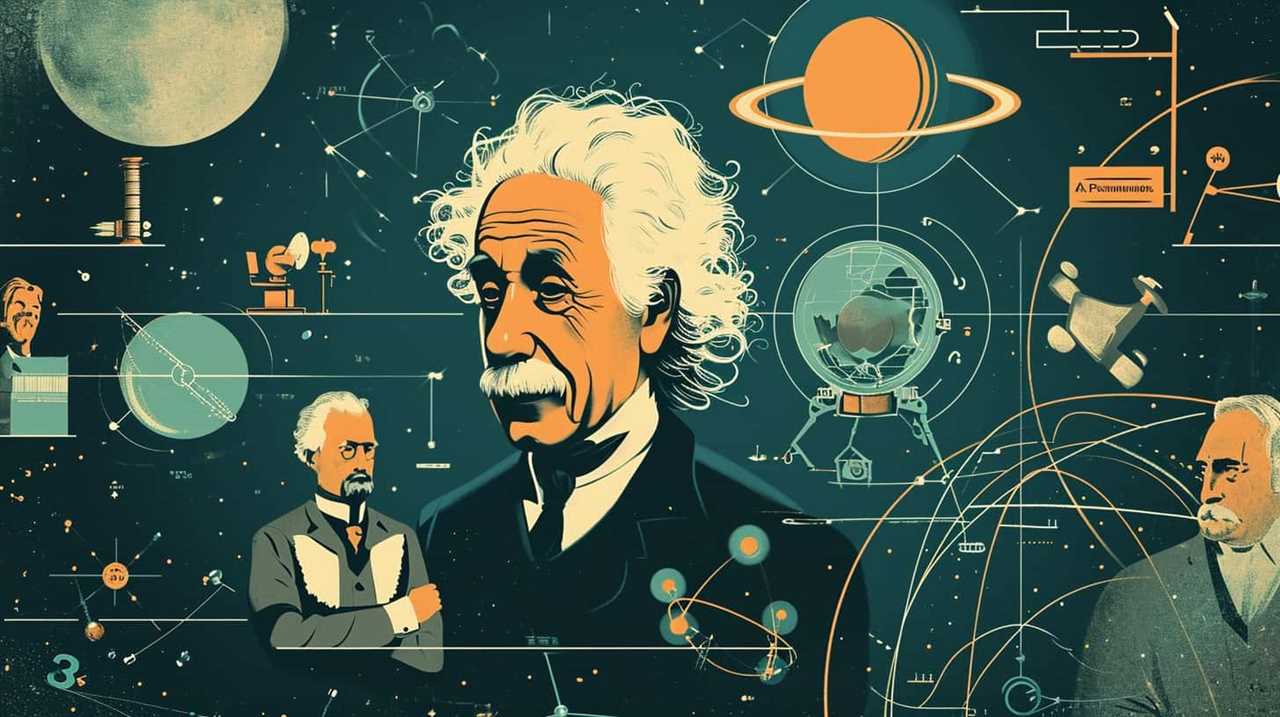When trying to understand the enigmatic realm of quantum metaphysics, scholars have offered a variety of fascinating explanations. These insights, crafted by brilliant minds, offer fresh perspectives and innovative ways of examining the fundamental elements of existence.
From Bohr’s Complementarity Principle to Heisenberg’s Uncertainty Principle, from Schrödinger’s Wave Function Interpretation to Everett’s Many-Worlds Interpretation, these theories challenge the boundaries of our imagination. Wheeler’s Participatory Anthropic Principle, Penrose’s Objective Reduction Theory, Bohm’s Implicate Order Interpretation, and Von Neumann’s Measurement Problem Solution further contribute to this intellectual tapestry.
Each interpretation unveils a unique lens through which we can glimpse the mysterious and awe-inspiring universe of quantum physics. Join us as we embark on a mind-expanding journey through the 8 best interpretations of quantum metaphysics by these visionary thinkers.
Key Takeaways
- Bohr’s Complementarity Principle and the wave-particle duality challenge classical intuition and understanding of reality.
- Schrödinger’s Wave Function Interpretation and Everett’s Many-Worlds Interpretation suggest multiple possibilities can coexist simultaneously, questioning the idea of a single objective reality.
- Wheeler’s Participatory Anthropic Principle raises questions about the role of consciousness in the quantum realm and suggests that observers play an integral part in shaping quantum systems.
- Quantum metaphysics has implications for our understanding of reality, matter, and spacetime, and opens up new possibilities for innovative thinking and technological applications in areas such as quantum computing and communication.

Bohr’s Complementarity Principle
We believe that Bohr’s Complementarity Principle is a fundamental concept in quantum metaphysics. Complementarity refers to the idea that certain properties of a quantum system can’t be observed simultaneously. This principle suggests that there’s a duality within quantum phenomena, where particles can exhibit both wave-like and particle-like behavior. It highlights the wave-particle nature of quantum entities, emphasizing that they possess characteristics of both waves and particles.
In this context, the wave-particle duality implies that depending on the experimental setup, quantum entities can exhibit either wave-like properties, such as interference and diffraction, or particle-like properties, such as localization and quantization. This duality challenges our classical intuition and forces us to rethink our understanding of reality at the quantum level.
Bohr’s Complementarity Principle raises intriguing questions about the nature of reality and the limitations of our observations. It suggests that our knowledge of quantum systems is inherently limited due to the complementary nature of the properties we measure. This concept serves as a cornerstone in the development of quantum mechanics and has led to innovative interpretations of quantum metaphysics.
Transitioning to the subsequent section on Heisenberg’s Uncertainty Principle, we can see that it builds upon Bohr’s Complementarity Principle by quantifying the limits of our knowledge about a particle’s position and momentum simultaneously.

Heisenberg’s Uncertainty Principle
Building upon Bohr’s Complementarity Principle, Heisenberg’s Uncertainty Principle introduces a crucial concept in quantum metaphysics regarding the limitations of simultaneously knowing the position and momentum of a particle. Heisenberg’s uncertainty principle states that there are inherent measurement limitations in quantum mechanics, leading to what’s known as quantum indeterminacy.
According to the uncertainty principle, it’s impossible to precisely determine both the position and momentum of a particle simultaneously. The more accurately we try to measure one of these properties, the less accurately we can know the other. This principle challenges the classical notion of determinism and introduces a fundamental level of randomness and unpredictability into the fabric of reality.
Heisenberg’s uncertainty principle has profound implications for our understanding of the microscopic world. It suggests that at the quantum level, the very act of measurement disturbs the system being observed. This raises questions about the nature of reality and the role of the observer in shaping it.
Innovative interpretations of the uncertainty principle have emerged, proposing new ways to understand the inherent limitations of measurement in quantum mechanics. Some theorists speculate that the uncertainty principle isn’t merely a result of measurement techniques but reflects a fundamental property of the universe itself. Others explore the possibility of hidden variables or alternative formulations of quantum mechanics that could reconcile the uncertainty principle with determinism.
The uncertainty principle challenges our intuition and calls for creative thinking to develop new frameworks that can accommodate its implications. It invites us to question our assumptions about the nature of reality and pushes the boundaries of our understanding of the quantum world.

Schrödinger’s Wave Function Interpretation
Continuing the exploration of quantum metaphysics, let’s now delve into the significance of Schrödinger’s Wave Function Interpretation. This interpretation, formulated by Erwin Schrödinger in the 1920s, revolutionized our understanding of the fundamental nature of reality.
At its core, Schrödinger’s interpretation addresses the wave-particle duality that lies at the heart of quantum mechanics.
In this interpretation, the wave function represents a mathematical description of a quantum system. It provides information about the probability distribution of a particle’s properties, such as its position or momentum. However, unlike the Collapse Interpretation, which suggests that the act of observation causes the system to collapse into a definite state, Schrödinger’s interpretation allows for multiple possibilities to coexist simultaneously, known as superposition.
This concept of superposition challenges our classical intuitions, as it implies that a particle can exist in multiple states until it’s observed or measured. It suggests a profound interconnectedness between different possibilities, with the wave function encompassing all possible outcomes.
Schrödinger’s Wave Function Interpretation has paved the way for further philosophical and scientific inquiries into the nature of reality. It has sparked debates and inspired innovative theories, pushing the boundaries of our understanding.

Everett’s Many-Worlds Interpretation
When exploring Everett’s Many-Worlds Interpretation, we’re confronted with the mind-bending implications of the multiverse theory.
This interpretation posits that the universe branches into multiple parallel realities, each representing a different outcome of a quantum event.
This raises intriguing questions about the nature of probability and the concept of superposition, as well as the observable consequences that could potentially be detected in experiments.
Multiverse Theory Implications
The article explores the implications of the multiverse theory, specifically focusing on Everett’s Many-Worlds Interpretation. This interpretation suggests that every possible outcome of a quantum event exists in a separate parallel universe.
The concept of parallel universes raises intriguing possibilities, including potential time travel implications. If every possible outcome exists in different universes, could it be possible to travel between these universes and explore different points in time? This idea challenges our understanding of causality and the linear nature of time.
It opens up a realm of possibilities for innovation and exploration, where we could potentially interact with different versions of ourselves and witness the consequences of different choices.
The multiverse theory and Everett’s interpretation offer a captivating framework for contemplating the nature of reality and the potential of alternate dimensions.
Probability and Superposition
One of the key aspects of Everett’s Many-Worlds Interpretation is the concept of probability and superposition. In this interpretation, quantum systems exist in a superposition of all possible states simultaneously, with each state corresponding to a different branch of reality. This leads to the idea that the probability of observing a particular outcome is determined by the amplitude of the corresponding state in the wave function.
Here are some intriguing implications of this concept:
- Quantum entanglement: The entangled states of particles can be understood as different branches of reality that remain connected, even when separated by large distances.
- Wave-particle duality: The superposition of wave-like and particle-like properties suggests that objects can exist in multiple states simultaneously.
- Parallel universes: Each possible outcome of a measurement corresponds to a separate universe, all coexisting in a vast multiverse.
- Probabilistic nature of reality: The probabilities in quantum mechanics arise from the interference of different branches of reality.
- Eternal existence: The many-worlds interpretation implies an infinite number of parallel universes, each with its own version of reality.
Understanding probability and superposition in the context of quantum mechanics opens up new possibilities for exploration and innovation. These concepts challenge our intuitions about the nature of reality and inspire new approaches to scientific inquiry.
In the next section, we’ll delve into the observable consequences of these ideas in experiments, further expanding our understanding of quantum metaphysics.
Observable Consequences in Experiments
To understand the observable consequences in experiments of Everett’s Many-Worlds Interpretation, we explore the outcomes of quantum measurements in relation to the existence of parallel universes.
In this interpretation, the wave-particle duality is embraced, suggesting that particles exist in a superposition of states until observed. However, instead of the wavefunction collapsing into a single outcome, as proposed by other interpretations, Everett’s Many-Worlds Interpretation suggests that every possible outcome actually occurs, resulting in the creation of multiple parallel universes.
This implies that every measurement outcome observed in our universe is just one of many possible outcomes that occur simultaneously in different parallel universes.
This speculative interpretation challenges our traditional understanding of reality and opens up new possibilities for innovation and exploration in the realm of quantum metaphysics.

Wheeler’s Participatory Anthropic Principle
Our exploration of Wheeler’s Participatory Anthropic Principle delves into the profound implications of human observation in shaping the very fabric of the quantum world. Wheeler’s participatory anthropic principle posits that the act of observation plays a fundamental role in the existence and properties of the universe. This concept, rooted in quantum information theory, suggests that our observations not only reveal the nature of reality but actively participate in its creation.
- The observer as a fundamental component: Wheeler’s principle challenges the traditional view of an objective reality independent of observation, suggesting that the observer is an integral part of the quantum system.
- The role of information: According to Wheeler, information is the bedrock of reality. Our observations generate and influence the flow of information, shaping the behavior of quantum systems.
- The collapse of the wave function: Wheeler’s principle offers a unique perspective on the collapse of the wave function. It suggests that the observer’s interaction with a quantum system triggers the collapse, determining its state.
- The interconnectedness of observers: Wheeler’s principle implies that all observers are interconnected, influencing each other’s observations and collectively participating in the creation of reality.
- The significance of consciousness: This principle raises profound questions about the role of consciousness in the quantum realm and its potential influence on the nature of the universe.
As we delve deeper into the implications of Wheeler’s Participatory Anthropic Principle, we transition to Penrose’s Objective Reduction Theory, which provides another intriguing perspective on the nature of quantum reality.

Penrose’s Objective Reduction Theory
Penrose’s Objective Reduction Theory offers a unique perspective on the connection between consciousness and quantum gravity.
By positing that consciousness arises from quantum processes occurring in the brain, Penrose challenges traditional views of the mind-body problem.
Furthermore, his theory has profound implications for our understanding of the fundamental nature of reality, suggesting that quantum phenomena may play a central role in the fabric of the universe.
Penrose’s Consciousness Connection
In our exploration of quantum metaphysics, we delve into the intriguing theory proposed by Penrose regarding the connection between consciousness and objective reduction.
Penrose suggests that consciousness may arise from quantum physics, specifically through a process called objective reduction. This theory posits that consciousness isn’t simply a byproduct of brain activity, but an integral part of the fundamental fabric of reality itself.
To understand this connection, Penrose emphasizes the role of mathematical models in unlocking the mysteries of consciousness. Mathematical frameworks, such as quantum mechanics, offer a powerful tool for exploring the intricate workings of the mind. By employing mathematical models, we can gain deeper insights into the nature of consciousness and its relationship to the quantum realm.
Transitioning into the subsequent section about ‘quantum gravity implications’, we now turn our attention to the implications of Penrose’s theory on the unification of quantum mechanics and gravity.
Quantum Gravity Implications
Transitioning from the exploration of Penrose’s Consciousness Connection, we now delve into the quantum gravity implications of his objective reduction theory. This theory posits that the collapse of the wave function, a central concept in quantum mechanics, is due to a process that occurs on the Planck scale, where gravity becomes significant. The implications of this theory for quantum gravity are intriguing and have sparked much speculation and debate among physicists.
One of the key implications is the potential resolution of the black hole information paradox. This paradox arises from the fact that according to quantum mechanics, information cannot be destroyed, while the presence of a black hole suggests that information is lost forever. Penrose’s objective reduction theory offers a possible solution by suggesting that the collapse of the wave function in a black hole could preserve and encode the information within its event horizon.
To further illustrate the potential implications of Penrose’s theory, consider the following table:
| Quantum Entanglement | Black Hole Information Paradox | Quantum Gravity Implications |
|---|---|---|
| Quantum entanglement is a phenomenon in which two or more particles become correlated in such a way that the state of one particle cannot be described independently of the others. | The black hole information paradox refers to the conflict between the principles of quantum mechanics and the classical theory of general relativity, which suggests that information entering a black hole is lost forever. | Penrose’s objective reduction theory offers a potential resolution to the black hole information paradox by suggesting that the collapse of the wave function within a black hole could encode and preserve information within its event horizon. |
| Quantum entanglement plays a crucial role in various quantum technologies, such as quantum computing and quantum communication. | Resolving the black hole information paradox is of great importance, as it has implications for our understanding of the fundamental principles of the universe. | The implications of Penrose’s objective reduction theory for quantum gravity could revolutionize our understanding of the behavior of matter and spacetime at the smallest scales. |
| Quantum entanglement has been experimentally demonstrated and is a well-established phenomenon in quantum mechanics. | The black hole information paradox remains a major challenge in theoretical physics, and its resolution could have profound implications for our understanding of the nature of reality. | The potential resolution of the black hole information paradox through Penrose’s objective reduction theory could lead to a deeper understanding of the relationship between quantum mechanics and gravity, bringing us closer to a unified theory of physics. |

Bohm’s Implicate Order Interpretation
Our exploration of quantum metaphysics leads us to delve into Bohm’s Implicate Order Interpretation. This interpretation, proposed by physicist David Bohm, offers a unique perspective on the nature of reality and the fundamental principles that govern it.
In Bohm’s Implicate Order Interpretation, reality is seen as a holographic manifestation of an underlying implicate order. This implicate order contains the potential for all possible states and forms, which are then unfolded and expressed in the explicate order that we perceive. This concept challenges our traditional understanding of reality, suggesting that what we observe is merely a projection of a deeper, interconnected reality.
Key ideas within Bohm’s interpretation include:
- Holographic reality: Reality is likened to a hologram, where each part contains information about the whole. This implies that every aspect of the universe is interconnected and inseparable.
- Non-locality: According to Bohm, particles can exhibit a non-local connection, meaning their behavior is influenced instantaneously regardless of distance. This challenges our conventional notion of causality.
- Interconnectedness: Bohm emphasizes the interconnected nature of all things, suggesting that everything is intimately related and influenced by each other.
- Enfoldment and unfoldment: The implicate order enfolded within itself contains the potential for all possible forms. These forms then unfold into the explicate order, the world of our direct experience.
- Holomovement: Bohm introduces the concept of holomovement, which describes the dynamic and inseparable nature of the implicate and explicate orders.
Bohm’s Implicate Order Interpretation offers a thought-provoking perspective on the nature of reality, challenging our conventional understanding and encouraging us to explore the interconnectedness and potentiality that lies within the fabric of existence. By embracing these concepts, we open ourselves to new possibilities and innovative ways of thinking about the universe.

What Are Some Quantum Metaphysics Interpretations That Aristotle Has Explored in His Reflections on Reality?
Metaphysical reflections by Aristotle offer insightful interpretations of quantum metaphysics. Exploring the realm of reality, Aristotle delves into the mysterious nature of existence and contemplates various interpretations. His profound insights shed light on the intricate relationship between matter, consciousness, and the fundamental fabric of the universe. With his exploration of quantum metaphysics, Aristotle provides a timeless perspective that continues to inspire philosophical discourse today.
Von Neumann’s Measurement Problem Solution
One possible solution to the measurement problem in quantum metaphysics is presented by von Neumann’s theory. According to von Neumann, the act of measurement leads to the collapse of the quantum state into one of the possible measurement outcomes. This collapse is governed by what’s known as von Neumann’s collapse postulate. This postulate states that when a measurement is made, the wave function of the system collapses into one of the eigenstates of the observable being measured.
However, von Neumann’s theory has faced criticism due to the subjective nature of the collapse postulate. Critics argue that it introduces an arbitrary distinction between the observer and the observed, leading to a problematic dualism.
To address these concerns, quantum decoherence theory offers a potential resolution. This theory suggests that the interaction of a quantum system with its environment causes the superposition of states to rapidly decay, resulting in the appearance of a classical outcome. In other words, decoherence provides a mechanism for the emergence of classical behavior from the underlying quantum dynamics.

Frequently Asked Questions
How Did Bohr’s Complementarity Principle Contribute to Our Understanding of Quantum Metaphysics?
Bohr’s complementarity principle contributed by offering a novel perspective on quantum metaphysics. However, it also has limitations as it focuses on the dual nature of particles, leaving room for further exploration and alternative interpretations.
What Are the Implications of Heisenberg’s Uncertainty Principle on Our Perception of Reality?
The implications of Heisenberg’s uncertainty principle on our perception of reality are profound. The observer effect highlights the inseparable relationship between uncertainty and determinism, challenging our conventional understanding and inviting innovative interpretations of quantum metaphysics.
How Does Schrödinger’s Wave Function Interpretation Explain the Behavior of Quantum Particles?
Schrödinger’s wave equation provides an abstract framework to understand the probabilistic behavior of quantum particles. It introduces the concept of wave-particle duality and allows for quantum superposition, offering innovative insights into the behavior of the microscopic world.
What Are the Key Ideas Behind Everett’s Many-Worlds Interpretation and How Does It Challenge Traditional Views of Reality?
Everett’s many-worlds interpretation challenges traditional views of reality by proposing that every quantum measurement creates a branching universe. The key ideas behind this interpretation include quantum superposition, wavefunction collapse, and the existence of parallel universes.
How Does Wheeler’s Participatory Anthropic Principle Address the Role of Conscious Observers in Shaping Reality According to Quantum Metaphysics?
The participatory anthropic principle, proposed by Wheeler, explores the conscious observer’s influence on shaping quantum reality. By acknowledging our role in the construction of reality, it challenges traditional views and opens up new possibilities for understanding the nature of existence.

Conclusion
In exploring the intricacies of quantum metaphysics, thinkers have offered a myriad of interpretations that push the boundaries of our understanding. From Bohr’s Complementarity Principle to Von Neumann’s Measurement Problem Solution, each interpretation adds a unique perspective to the enigmatic world of quantum mechanics.
As we delve deeper into these theories, we’re reminded of the adage, ‘The only constant is change.’ Indeed, the ever-evolving nature of quantum metaphysics challenges us to continuously question and expand our knowledge of the universe.
Lauren’s talent in writing is matched by her passion for storytelling. Her love for books and deep understanding of culture and entertainment add a distinct flavor to her work. As our media and press contact, Lauren skillfully bridges the gap between afterQuotes and the broader media landscape, bringing our message to a wider audience.










